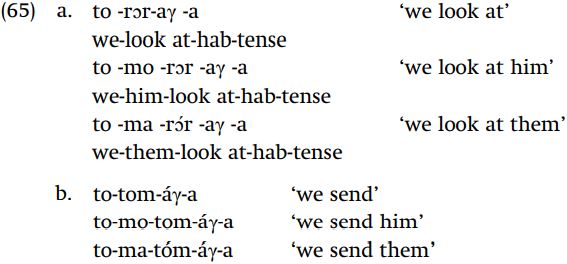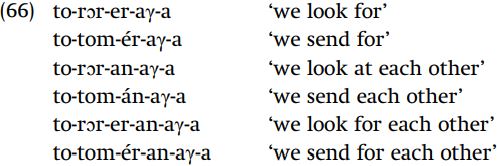
Tonal mobility
 المؤلف:
David Odden
المؤلف:
David Odden
 المصدر:
Introducing Phonology
المصدر:
Introducing Phonology
 الجزء والصفحة:
303-9
الجزء والصفحة:
303-9
 14-4-2022
14-4-2022
 1581
1581
Tonal mobility
The final demonstration of the autonomy of tone from segments is the tone mobility, which is the fact that tones can move about from vowel to vowel quite easily, in a fashion not shared with segmental properties. One example of tonal mobility comes from Nkore, seen in (63). This language has an underlying contrast between words whose last syllable is H toned, and those whose penultimate syllable is H toned. In prepausal position, underlyingly final H tones shift to the penultimate syllable, thus neutralizing with nouns having an underlyingly penult H. When some word follows the noun, the underlying position of the H tone is clearly revealed.

There are a number of reasons internal to the grammar of Nkore for treating L tone as the default tone, and for only specifying H tones in the phonology so that phonetically L-toned vowels are actually toneless. This alternation can be accounted for by the following rule of tonethrowback.

Another example of tone shift can be seen in Kikuyu. Like Nkore, there are good reasons to analyze this language phonologically solely in terms of the position of H tones, with vowels not otherwise specified as H being realized phonetically with a default L tone. We will follow the convention adopted in such cases as marking H-toned vowels with an acute accent, and not marking toneless (default L) vowels.
Consider the Kikuyu data in (65), illustrating the current habitual tense. The first two examples in (65a) would indicate that the morphemes to-, -rɔr-, -aγ-, and -a are all toneless. The third example, however, shows the root rɔr with an H tone: this happens only when the root is preceded by the object prefix ma. In (65b), we see that – in contrast to what we see in (65a) – the habitual suffix -aγ- has an H tone when it is preceded by the root tom (which is itself toneless on the surface). As with (65a), the syllable that follows ma has an H tone.

It is clear, then, that certain syllables have the property of causing the following syllable to have a surface H tone. This is further demonstrated in (66), where the derivational suffixes -er- and -an- follow the roots -rɔr-and -tom-: we can see that the syllable after -tom always receives an H tone.

Further examples of this phenomenon are seen in the examples of the recent past in (67). In (67a), the root rɔr (which generally has no H tone) has an H tone when it stands immediately after the recent-past-tense prefix -a-; or, the object prefix that follows -a- will have a surface H tone. The examples in (67b) show the same thing with the root –tom-which we have seen has the property of assigning an H tone to the following vowel.

We would assume that the root -tóm- has an H, as do the object prefix –má-and the tense prefix -a-, and this H tone is subject to the following rule of tone shift, which moves every H tone one vowel to the right.

Thus, /to-tóm-er-aγ-a/ becomes totoméraγa, /to-má-rɔr-aγ-a/ becomes tomarɔ́ - raγa, and /to-á-má-tóm-a/ becomes toamátómá.

An even more dramatic example of tone shifting comes from Digo. In this language, the last H tone of a word shifts to the end of the word. The root vugura is toneless, as is the object prefix ni, but the object prefix a ‘them’ has an underlying H tone, which is phonetically realized on the last vowel of the word. Similarly, the root togora is toneless, as is the subject prefix ni, but the third-singular subject prefix a has an H tone, which shifts to the end of the word. Lastly, the root t s ukura is toneless, as is the tense-aspect prefix -na-, but the perfective prefix ka has an H tone which shifts to the last vowel of the word.

These data can be accounted for by a rule of tone shift which is essentially the same as the Kikuyu rule, differing only in that the tone shifts all the way to the end of the word.

 الاكثر قراءة في Phonology
الاكثر قراءة في Phonology
 اخر الاخبار
اخر الاخبار
اخبار العتبة العباسية المقدسة


